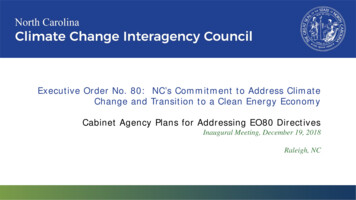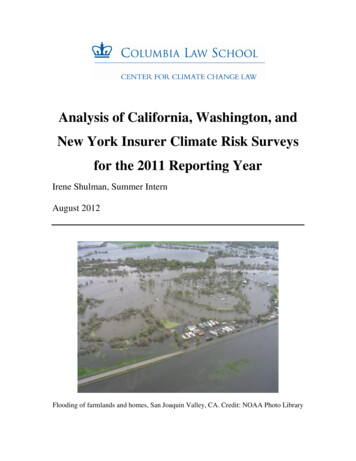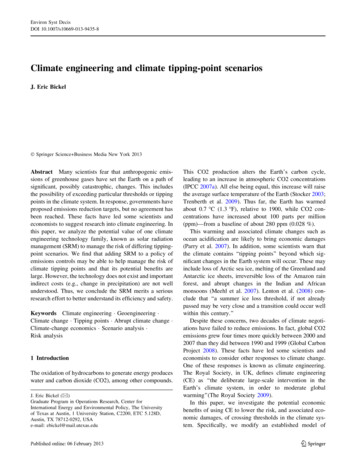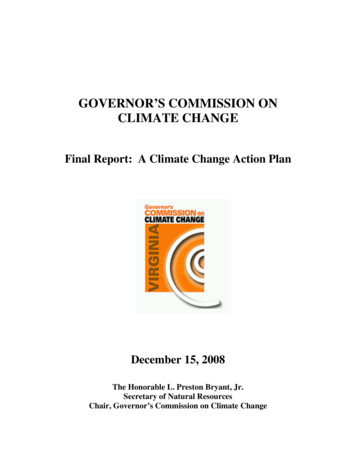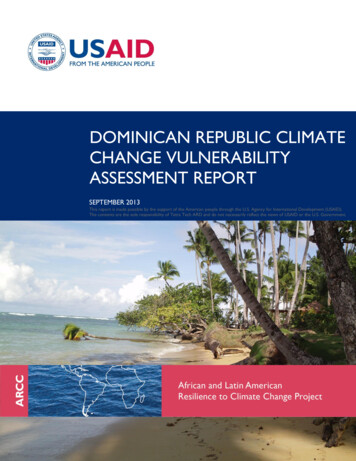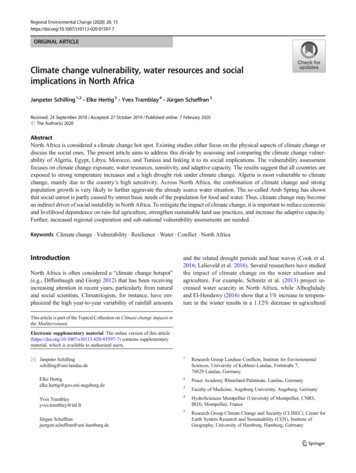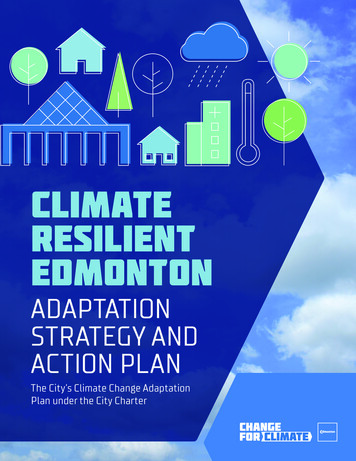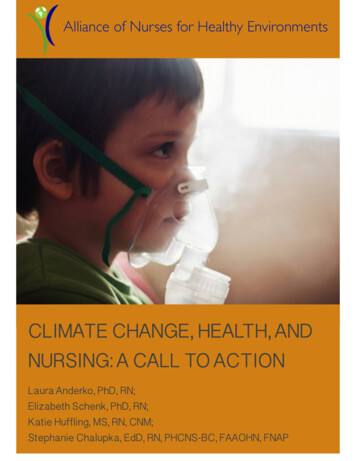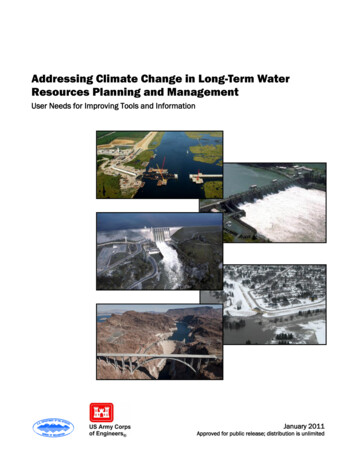
Transcription
Addressing Climate Change in Long-Term WaterResources Planning and ManagementUser Needs for Improving Tools and InformationJanuary 2011Approved for public release; distribution is unlimited
Form ApprovedOMB No. 0704-0188REPORT DOCUMENTATION PAGEPublic reporting burden for this collection of information is estimated to average 1 hour per response, including the time for reviewing instructions, searching existing data sources, gathering and maintainingthe data needed, and completing and reviewing this collection of information. Send comments regarding this burden estimate or any other aspect of this collection of information, including suggestions forreducing this burden to Department of Defense, Washington Headquarters Services, Directorate for Information Operations and Reports (0704-0188), 1215 Jefferson Davis Highway, Suite 1204, Arlington,VA 22202-4302. Respondents should be aware that notwithstanding any other provision of law, no person shall be subject to any penalty for failing to comply with a collection of information if it does notdisplay a currently valid OMB control number. PLEASE DO NOT RETURN YOUR FORM TO THE ABOVE ADDRESS.1. REPORT DATE (DD-MM-YYYY)2. REPORT TYPEJanuary 2011Technical Report3. DATES COVERED (From - To)4. TITLE AND SUBTITLE5a. CONTRACT NUMBERAddressing Climate Change in Long-Term Water Resources Planning and Management:User Needs for Improving Tools and Information Title5b. GRANT NUMBER5c. PROGRAM ELEMENT NUMBER6. AUTHOR(S)5d. PROJECT NUMBERLevi D. BrekkeBureau of ReclamationTechnical Service Center5e. TASK NUMBER5f. WORK UNIT NUMBER7. PERFORMING ORGANIZATION NAME(S) AND ADDRESS(ES)8. PERFORMING ORGANIZATION REPORTNUMBERU.S. Army Corps of EngineersBureau of Reclamation, U.S. Department of the InteriorCWTS 10-029. SPONSORING / MONITORING AGENCY NAME(S) AND ADDRESS(ES)10. SPONSOR/MONITOR’S ACRONYM(S)U.S. Department of the InteriorBureau of Reclamation,Washington, DC 20240-000111. SPONSOR/MONITOR’S REPORTNUMBER(S)U.S. Army Corps of EngineersWashington, DC 20314-100012. DISTRIBUTION / AVAILABILITY STATEMENTAvailable from the National Technical Information ServiceOperations Division, 5285 Port Royal Road, Springfield VA 2216113. SUPPLEMENTARY NOTESReport can be downloaded from the Reclamation Web site: www.usbr.gov/climate/userneeds14. ABSTRACTThis document describes the water management community’s needs for climate change information and tools to support long-termplanning. Reclamation and the U.S. Army Corps of Engineers (USACE) technical specialists and program managers have worked withtheir planners, water operators, and environmental compliance managers to identify the information and tools most relevant to theirprograms. Reclamation and USACE also have engaged and consulted with other Federal, State, and local agencies and stakeholdergroups that have a role in water and water-related resource management to identify complementary priorities and individualperspectives. This document is meant to help focus research and technology efforts to address information and tools gaps relevant to thewater management user community.Technical climate change information may be incorporated into longer-term water resources planning using various methods. In thisreport, eight technical steps representative of these various methods are used to categorize tools and information needs (i.e., gaps): 1.Summarize Relevant Literature; 2. Obtain Climate Change Information; 3. Make Decisions About How To Use the Climate ChangeInformation; 4. Assess Natural Systems Response; 5. Assess Socioeconomic and Institutional Response; 6. Assess System Risks andEvaluate Alternatives; 7. Assess and Characterize Uncertainties; and 8. Communicating Results and Uncertainties to Decisionmakers.15. SUBJECT TERMSWater management, climate change, water-related resource management, tools gaps, water management user community, literaturereview, climate change information, natural systems response, system risks, uncertainties16. SECURITY CLASSIFICATION OF:17. LIMITATIONOF ABSTRACT18. NUMBEROF PAGES19a. NAME OF RESPONSIBLEPERSONLevi Brekkea. REPORTUb. ABSTRACTUc. THIS PAGEU19b. TELEPHONE NUMBER (includeU161area code)303-445-2494Standard Form 298 (Rev. 8-98)Prescribed by ANSI Std. 239.18
Addressing Climate Change in Long-Term WaterResources Planning and ManagementUser Needs for Improving Tools and InformationU.S. Army Corps of Engineers Civil Works Technical Series CWTS-10-02Levi D. Brekke, Bureau of Reclamation, Technical Service Center, Lead AuthorContributing Authors, U.S. Army Corps of Engineers:Kathleen White and J. Rolf Olsen, Institute for Water ResourcesEdwin Townsley, South Pacific DivisionDavid Williams, Tulsa DistrictFauwaz Hanbali, Hydrologic Engineering CenterContributing Authors, Bureau of Reclamation:Chuck Hennig and Curt Brown, Research and Development OfficeDavid Raff, Policy and AdministrationRod Wittler, Mid-Pacific RegionPrepared by and for:U.S. Army Corps of EngineersWashington, DCU.S. Department of the InteriorBureau of ReclamationWashington, DCUnder:USACE Campaign Plan Goal 2 and Bureau of Reclamation Science and Technology ProgramMonitored by: USACE Senior Executive Service Leader: James Dalton, P.E.andBureau of Reclamation, Senior Executive Service Leader: Michael Gabaldon, P.E.January 2011
CWTS 10-02AbstractThis document describes the water management community‘s needs forclimate change information and tools to support long-term planning.Reclamation and the U.S. Army Corps of Engineers (USACE) technicalspecialists and program managers have worked with their planners, wateroperators, and environmental compliance managers to identify theinformation and tools most relevant to their programs. Reclamation andUSACE also have engaged and consulted with other Federal, State, andlocal agencies and stakeholder groups that have a role in water and waterrelated resource management to identify complementary priorities andindividual perspectives. This document is meant to help focus researchand technology efforts to address information and tools gaps relevant tothe water management user community.Technical climate change information may be incorporated into longerterm water resources planning using various methods. In this report,eight technical steps representative of these various methods are used tocategorize tools and information needs (i.e., gaps): 1. SummarizeRelevant Literature; 2. Obtain Climate Change Information; 3. MakeDecisions About How To Use the Climate Change Information; 4. AssessNatural Systems Response; 5. Assess Socioeconomic and InstitutionalResponse; 6. Assess System Risks and Evaluate Alternatives; 7. Assessand Characterize Uncertainties; and 8. Communicating Results andUncertainties to Decisionmakers.ii
CWTS 10-02A Joint Message from the Commissioner, Bureau of Reclamation, andthe Director of Civil Works, U.S. Army Corps of Engineers:Water resources underpin our quality of life and our national economy. Climatechange impacts to water and water-dependent resources present new andcomplex challenges to the water resources management community. Meetingthese challenges will require close collaboration between the water resourcesmanagement community and the science community to develop and apply newand improved scientific information and technical tools.With this publication, the Bureau of Reclamation and the U.S. Army Corps ofEngineers, as part of the Climate Change and Water Working Group, offer ourjoint agency perspectives on user needs we have identified to help us meet thischallenge for long-term water resources planning. We also recognize the otherFederal and non-Federal water resource organizations and interest groups thathave contributed their perspectives to this document. We have published thesecontributed perspectives along with our own, and offer a synthesis of thecollective messages heard.We hope this document takes a step toward communicating a collectiveexpression of needs from the water resources community of practice to thescience community and fosters closer collaboration and expedited application ofresearch results. As a next step, we encourage other water and natural resourceuser and coordination groups, such as the U.S. Department of the Interior (DOI)Landscape Conservation Cooperatives, to assist as new capabilities and newknowledge are applied and new perspectives and insights are gained.We also encourage the science community to rally behind these needs withcollaborative research and development (R&D) efforts to build the capabilitiesthat we have identified. We look forward to effective, collaborative R&D acrossthis community, including organizations such as the DOI Climate ScienceCenters, National Oceanic and Atmospheric Administration Regional IntegratedScience and Assessment Centers, National Science Foundation and other Federaland non-Federal science organizations, as well as our own science capabilities.As water resource management agencies, we stand ready to work with the sciencecommunity.iii
CWTS 10-02AcknowledgementsExecutive SponsorsBureau of ReclamationMichael Gabaldon – Director, Technical ResourcesKarl Wirkus – Regional Director, Pacific Northwest Region(formerly Deputy Commissioner of Operations)U.S Army Corps of EngineersSteven Stockton – Director of Civil WorksRobert Pietrowsky – Director of Institute for Water ResourcesJames C. Dalton – Chief, Engineering and ConstructionTheodore A. Brown – Chief, Planning and PolicyReclamation Reviews Provided by:Great Plains Region – Eastern Colorado Area OfficeLower Colorado Region – Regional OfficeMid-Pacific Region – Central California Area OfficeMid-Pacific Region – Regional OfficePacific Northwest Region – Regional OfficeUSACE Reviews Provided by:Great Lakes and Ohio River DivisionSouth Atlantic DivisionSouth Atlantic Division–Jacksonville DistrictNorthwestern Division–Portland DistrictNorthwestern Division–Walla Walla DistrictReview, Advice, and Contributions by:Karen Metchis – Environmental Protection Agency – Office of WaterNancy Steinberger – Federal Emergency Management AgencyEarl Greene – Unites States Geological Survey – Water ResourcesDisciplineRobert Webb – National Oceanic and Atmospheric Administration –Earth System Research LaboratoryMichael Alexander – National Oceanic and Atmospheric Administration –Earth System Research Laboratoryv
viCWTS 10-02Andrea Ray – National Oceanic and Atmospheric Administration – EarthSystem Research LaboratoryJoseph Barsugli – National Oceanic and Atmospheric Administration –University of Colorado Cooperative Institute for Research inEnvironmental ScienceEdited by:David Cate – USACE – Remote Sensing/GIS Center of ExpertisePatty Alexander – Reclamation – Technical Service CenterIndependent perspectives were contributed and published in thisreport by representatives from the following organizations:Non-Federal organizations:American Society of Civil EngineersAmerican Water Works AssociationAssociation of Metropolitan Water AgenciesCalifornia Department of Water ResourcesCalifornia Water and Environmental Modeling ForumFamily Farm AllianceSeattle City LightWater Utility Climate AllianceWestern States Water CouncilOther Federal water and water-related management organizations:Federal Emergency Management AgencyFederal Energy Regulatory CommissionNOAA National Ocean Service - Coastal Services CenterPower Marketing Administration – Western Area Power AdministrationUSEPA – Office of Research and DevelopmentUSEPA – Office of WaterUSEPA – Region 8
CWTS 10-02Executive SummaryThe Bureau of Reclamation (Reclamation) and the United States ArmyCorps of Engineers (USACE) recognize that there is a critical need to beginincorporating climate change science into the design, construction, andoperations of our water resources management infrastructure. These twoagencies, together with the United States Geological Survey (USGS) andNational Oceanic and Atmospheric Administration (NOAA), formed aninteragency working group called the Climate Change and Water WorkingGroup (CCAWWG) in 2007 to provide scientific collaborations in supportof water management as climate changes. In February 2009, the fouragencies produced an interagency report, USGS Circular 1331, ClimateChange and Water Resources Management: A Federal Perspective,which provides a foundation to guide future policies, methods, andtechnologies.Building on the foundation established by USGS Circular 1331, CCAWWGis pursuing a collaborative process to better define the critical capabilitygaps that face the water management community and to define a soundscience strategy for filling the information gaps and providing criticaltools. The effort builds on chapter 6, table 2 of USGS Circular 1331 and isguided by the following objectives:Consolidate the Needs of the Water Management Community Identify the common needs of the Federal and non-Federal watermanagement community for information and tools required to supportadaptation as climate changes.Inform the Scientific Community - Guide and foster Federal and nonFederal research and technology investments toward meeting these―user-defined‖ needs.Teamwork - Generate collaborative efforts across the watermanagement and scientific communities to develop, test, and applynew methods, tools, and capabilitiesvii
viiiCWTS 10-02Flexible and Inclusive - Issue periodic updates as new information andadditional perspectives are obtained. It is unrealistic to assume that allrelevant perspectives can be represented in the initial release of a userneeds document. The intent is to seed the initial release with arepresentative cross section of the other Federal and non-Federal watermanagement perspectives and then use online networking technologiesto accommodate input and perspectives across the water managementcommunity of practice.To accomplish this aim, CCAWWG is developing four related documentsdescribing water managers‘ needs for climate change information tosupport both short-term and long-term water resources planning and thecomplementary science strategy to address those needs. The fourdocuments are as shown below, with the current document highlighted.Water Resources Planning Time Scale 5 years 5 yearsUser NeedsShort-Term NeedsLong-Term NeedsScience StrategyShort-Term Science StrategyLong-Term Science StrategyThis document, the Long-Term Needs document, describes the watermanagement community‘s needs for climate change information and toolsto support long-term planning. As two of the primary Federalrepresentatives of the water management community, Reclamation andUSACE technical specialists and program managers have worked withtheir planners, water operators, and environmental compliance managersto identify the information and tools most relevant to their programs.Reclamation and USACE also have engaged and consulted with otherFederal, State, and local agencies and stakeholder groups that have a rolein water and water-related resource management to identifycomplementary priorities and individual perspectives (see chapter 3 andappendix B).At the same time, Reclamation and the USACE have begun work on theShort-Term Needs document, describing water managers‘ needs forinformation to better manage water resources under short-term climatevariability and change. Climate variability involves fluctuations in climateconditions on time scales of months, years, and decades. Improved ability
CWTS 10-02to forecast and use climate variability information would greatly enhancethe ability of water managers and water users to plan their short-termoperations and water delivery schedules. The influence of climatechange on short-term climate variability is an additional factor that isnow central to this area of concern.In response to these user-needs documents, the USGS and NOAA willjointly prepare two documents describing respectively a science strategyfor meeting short-term and long-term needs for information and tools.Development of those documents also will incorporate perspectives fromother Federal and non-Federal representatives of the scientificcommunity.Note: This report refers to planning as the analyses conductedto inform decisions about water system development andmanagement. In contrast, USACE defines Planning as a six-stepprocess in accordance with Economic and EnvironmentalPrinciples and Guidelines for Water and Related ResourcesImplementation Studies (Water Resources Council 1983) and asauthorized by the Water Resources Development Act of 1986(Public Law 99-662) (see Orth and Yoe 1997). The Planningprocess includes decisionmaking under uncertainty, based oninformation from these analyses. Although decisionmaking is notexplicitly addressed in the planning definition of this report,many gaps in this report address how supporting analyses areaffected by knowledge limits and uncertainties. Research toaddress such gaps, thus, should benefit decisionmaking inPlanning processes.Audience: This document is meant to help focus research andtechnology efforts to address information and tools gaps relevant to thewater management user community. As such, the primary audience forthis document is the research and technology community in position toaddress these gaps. Such community members include CCAWWG scienceagencies (NOAA, USGS), other Federal research entities and programs(e.g., National Science Foundation, National Aeronautics and SpaceAdministration, U.S. Environmental Protection Agency, U.S. Departmentof Agriculture, U.S. Forest Service, Department of Energy), State and localix
xCWTS 10-02science centers, academic institutions, and the members of thepractitioner community that support climate and water resourcesresearch.Summary of Gap Categories: Technical climate change informationmay be incorporated into longer-term water resources planning usingvarious methods. For this report, eight technical steps representative ofthese various methods are used to categorize tools and information needs(i.e., gaps). These steps are:1. Summarize Relevant Literature: For a given planning study, this stepinvolves identifying, synthesizing, and summarizing previous research onglobal to regional climate change and what it means for the region‘s waterresources.2. Obtain Climate Change Information: This step involves obtainingcontemporary climate projections and associated uncertainties that mayhave been spatially downscaled to finer resolution desired for waterresources planning at the regional to local scale. This step also involvesconsideration of paleoclimate proxies that may imply climate conditionsdifferent from those of the observed record.3. Make Decisions About How To Use the Climate Change Information:From the body of climate projections surveyed, decisions must be made onwhich projections to use and which aspects of these projections to relate toplanning assumptions on water supplies, water demands, and operatingconstraints.4. Assess Natural Systems Response: Based on the preceding step‘sdecisions, this step involves assessing the natural systems response underprojected climate conditions. Results from these analyses will be used toset assumptions about future water supplies, water demands, andoperating constraints. Types of natural systems responses includewatershed hydrology, ecosystems, land cover, water quality, consumptiveuse requirements of irrigated lands, sedimentation and river hydraulics,and sea level rise.5. Assess Socioeconomic and Institutional Response: This step involvesassessing social, economic, and institutional responses to climate changethat could influence planning assumptions concerning water demands and
CWTS 10-02operating constraints (e.g., constraints that determine source of supplypreference and/or expected level of operating performance relative toobjectives such as flood risk reduction, environmental management, waterquality management, water allocation for agricultural and municipal use,energy production, recreation, and navigation).6. Assess System Risks and Evaluate Alternatives: This step involvesassessing system risks based on future planning assumptions (informed bySteps 4 and 5); and, as necessary, evaluating long-term managementalternatives to address climate change risks. For example, many waterresources management studies focus on operations risk and assumptionsabout future water supplies, demands, and operating constraints. Incontrast, infrastructure safety or flood risk reduction studies focus onhuman safety and economic and environmental damages underassumptions about future extreme hydrologic event probabilities; andwater quality studies focus on the interaction between the humanactivities, landscape hydrology, and aquatic systems.7. Assess and Characterize Uncertainties: This step involves assessing andcharacterizing uncertainties accumulated during preceding steps (e.g.,uncertainties of projecting future factors forcing climate, simulatingclimate, downscaling climate, assessing natural and social systemresponses, etc.).8. Communicating Results and Uncertainties to Decisionmakers: This stepinvolves aggregating information from previous steps and thencommunicating this distilled information to decisionmakers to supportplanning decisions.Table ES-1 provides an initial list of gaps in tools and informationassociated with these steps. Given the geographic areas served byReclamation and USACE, these gaps may be thought of as being nationallyrelevant. While this document presents gaps that are particularly relevantfor management of Reclamation and USACE water supply and riverregulation systems, it was envisioned that these gaps may be generallyapplicable for long-term management of any type of water infrastructure.To gauge this possibility, feedback on the gaps in table ES-1 was gatheredfrom non-Federal organizations and other Federal agencies. The mostfrequent relative priority (i.e., low, medium, high) assigned byReclamation and USACE for each gap is shown next to the most frequentxi
xiiCWTS 10-02relative priority received from all Federal (including Reclamation andUSACE) and non-Federal respondents combined. In the event of a tie, thelower priority was assigned. For example, if one gap had an equal numberof medium priority responses as high responses, then the gap was assigneda medium priority. An examination of table ES-1 shows the priorityrankings assigned by Reclamation/USACE compare favorably with thoseassigned by all respondents combined with only minor differences (e.g.,low versus medium or medium versus high) on 12 of the 39 gaps listed.Table ES-1. Summary of gaps and relation to other needs assessmentsPriority Ranking1Technical Planning Steps and Associated Gapsin Tools and InformationReclamation/USACEAllRespondentsOther AssessmentsHaving RelatedDiscussionStep 1 – Summarize Relevant Literature1.01 Access to a clearinghouse of climatechange literature relevant to watermanagement or access to a bibliography ofrecommended literature to represent inliterature syntheses.LowLowCCAWWG 20081.02 Region-specific literature summaries,regularly maintained and peer-reviewed.MediumMediumCCAWWG 2008Step 2 – Obtaining Climate Change Information2.01 Improved skill in simulating long-termglobal to regional climate.HighHighReclamation 2007,Western States WaterCouncil (WSWC) 20072.02 Downscaled data at finer space andtime resolutions and for different variables.HighHighCCAWWG 2008, WSWC20072.03 Information on the strengths andweaknesses of downscaled data and thedownscaling methodologies used todevelop these data (including both statisticaland dynamical methods and associatedapproaches for climate model biascorrection).HighHighWSWC 20072.04 Indication of conditions of where andwhen the stationarity assumption ofstatistical downscaling may not hold(defined above) and should motivate use ofdynamical downscaling techniques ratherthan statistical.MediumMedium2.05 Synthesis of sea level projectioninformation and guidance on consistent usein planning for all Reclamation andUSACE coastal areas.LowLowCCAWWG 2008, WSWC20071 Color shading indicates priority rating on research to address gaps: low (yellow), medium (light orange), andhigh (dark orange).
CWTS 10-02xiiiTable ES-1. Summary of gaps and relation to other needs assessments (continued)Priority Ranking1Technical Planning Steps and AssociatedGaps in Tools and InformationReclamation/USACEAllRespondentsOther AssessmentsHaving RelatedDiscussionStep 3 – Make Decisions About How To Use the Climate Change Information3.01 Understanding on observed climatevariability from daily to multidecadal timescales, which underpins interpretation offuture variability in climate projections andits relation to planning assumptions.HighHighReclamation 2007,WSWC 20073.02 Understanding how to interpret futurevariability in climate projections andrelevance to operating constraints onshorter- to longer-term time scales (fromdaily to multidecadal).HighHighReclamation 20073.03 Basis for culling or weighting climateprojections (if at all) when deciding whichprojections to use in planning.MediumMedium3.04 Guidance on how to appropriately relateplanning assumptions to either PeriodChange or Time-Developing aspects ofclimate projections when deciding how touse projections in planning.LowMedium3.05 Guidance on how to jointly utilize thelonger-term climate variability from observedrecords, paleoclimate, and projected climateinformation when portraying drought andsurplus possibilities in planning.MediumHighReclamation 2007,CCAWWG 2008HighHighCCAWWG 20083.06 Method and basis for estimatingextreme meteorological event possibilities,deterministically or probabilistically, in achanging climate.CCAWWG 2008Step 4 – Assess Natural Systems Response – Watershed Hydrology (WH), Ecosystems (E), LandCover (LC), Water Quality (WQ), Consumptive Use on Irrigated Lands (CU), and Sedimentation andRiver Hydraulics (SRH)4.01 (WH) Guidance on strengths andweaknesses of watershed hydrologicmodels/methods to support scopingdecisions in planning.LowLowCCAWWG 20084.02 (WH) Understanding how climatechange should impact potentialevapotranspiration and how it is representedin watershed hydrologic models.HighHighReclamation 20071 Color shading indicates priority rating on research to address gaps: low (yellow), medium (light orange), andhigh (dark orange).
xivCWTS 10-02Table ES-1. Summary of gaps and relation to other needs assessments (continued)Priority Ranking1Technical Planning Steps and AssociatedGaps in Tools and essmentsHaving RelatedDiscussionStep 4 – Assess Natural Systems Response – Watershed Hydrology (WH), Ecosystems (E), LandCover (LC), Water Quality (WQ), Consumptive Use on Irrigated Lands (CU), and Sedimentation andRiver Hydraulics (SRH) (continued)4.03 (WH) Method and basis for estimatingextreme hydrologic event possibilities,deterministically or probabilistically, in achanging climate. (Similar to Gap 3.06 butfocused here on hydrology rather thanmeteorological variables)HighHighCCAWWG 20084.04 (WH) Guidance on strengths andweaknesses of available versions ofspatially distributed hydrologic weatherdata that may be used for both watershedhydrologic model development (Step 4) andin climate model bias-correction (Step 2).MediumMedium4.05 (WH) Understanding how climatechange should impact groundwater rechargeand groundwater interaction with surfacewater supplies.MediumMediumReclamation2007, CCAWWG20084.06 (E) Understanding how climate changeshould impact inland and coastalanadromous fisheries.MediumLowCCAWWG 20084.07 (E) Understanding how climate changemay impact riparian ecosystems andvegetation that affect both longer-term waterbudgets and ecological resources.HighMediumCCAWWG 20084.08 (E) Understanding translated intomodel frameworks for assessing climatechange responses for fisheries, nonnativeriparian vegetation, and other species orhabitat conditions.HighMediumCCAWWG 20084.09 (LC) Understanding how climate and/orcarbon dioxide changes should impact landcover communities that control naturalevapotranspiration and soil erosion potential.MediumLowReclamation2007, CCAWWG20084.10 (WQ) Understanding how water qualitycharacteristics depend on climatic variablesand how dependencies may evolve in achanging climate.HighHigh4.11 (CU) Understanding how climate andcarbon dioxide changes should impact plantphysiology, how impacts vary with crop type,and how impacts affect irrigation demand.MediumMediumCCAWWG 20081 Color shading indicates priority rating on research to address gaps: low (yellow), medium (light orange),and high (dark orange).
CWTS 10-02xvTable ES-1. Summary of gaps and relation to other needs assessments (continued)Priority Ranking1Technical Planning Steps and Associated Gapsin Tools and essmentsHaving RelatedDiscussionStep 4 – Assess Natural Systems Response – Watershed Hydrology (WH), Ecosystems (E), LandCover (LC), Water Quality (WQ), Consumptive Use on Irrigated Lands (CU), and Sedimentation andRiver Hydraulics (SRH) (continued)4.12 (SRH) Understanding how climateand/or land cover changes will changewatershed sediment yield, changes insediment constituency, and the resultingimpacts on water resources.MediumMedium4.13 (SRH) Understanding how climate,land cover, and/or sedimentation changeswill affect river and reservoir ice-eventpotential.MediumLowStep 5 – Assess Socioeconomic and Institutional Response5.01 Understanding how socioeconomicfactors may affect flood risk reduction andreservoir regulation objectives in a changingclimate (e.g., flood protection values, landmanagement).MediumHighCCAWWG 20085.02 Understanding how socioeconomicfactors may affect water and power deliveryreliability, water allocations, as well asdecisions on source of supply under achanging climate (e.g., groundwaterpumping versus surface water diversion).HighHighCCAWWG 2008MediumLow5.03 Understanding how institutionalrealities currently control socioeconomicrespo
Bureau of Reclamation, U.S. Department of the Interior CWTS 10-02 9. SPONSORING / MONITORING AGENCY NAME(S) AND ADDRESS(ES) 10. SPONSOR/MONITOR'S ACRONYM(S) U.S. Department of the Interior U.S. Army Corps of Engineers Bureau of Reclamation, Washington, DC 20314-1000 Washington, DC 20240-0001 11. SPONSOR/MONITOR'S REPORT NUMBER(S) 12.

